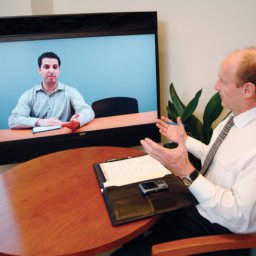Original Post by Sarah Murphy
Talk us about your video conferencing needs.
No amount of convenience that software tools and cloud services lend to arranging and joining meetings—in person, online or otherwise—seems to alleviate the frustrations of business people participating in those meetings.
Last year, the staffing firm Robert Half Management Resources interviewed more than 400 U.S. workers age 18 and over who were employed in office environments. Researchers asked: “In general, what percentage of the time you spend in meetings is wasted?” The average response was 25%, which means that on average 15 minutes of every hour-long meeting is a waste of time in the minds of attendees.
“Meetings are hands-down the most ironic aspect of workplace culture today,” Staff Writer Sharon Florentine writes in a recent post on CIO.com.
“Why? Because no self-respecting business wants to advertise that it’s inefficient, unfocused, lacks a clear direction or purpose or that they regularly waste tens of thousands of dollars for no tangible reason,” Florentine elaborates.
“Maybe it’s the leader’s fault, and they need to learn how to run better meetings,” opines Dan McCarthy in a recent post for the SmartBlog on Leadership . McCarthy, who is the director of Executive Development Programs at the University of New Hampshire and runs the Management & Leadership channel of About.com, recommends managers and executives attend a “day of training” geared specifically toward optimizing meeting time.
Here’s a digest of McCarthy’s tips for meeting leaders along with suggestions from other management gurus:
1. Consider scheduling for peak performance
“The most important tasks should be conducted when people are at or near their peaks in alertness (within an hour or so of noon and 6pm),” writes Christopher M. Barnes in an article for Harvard Business Review.
Barnes is an assistant professor at University of Washington’s Foster School of Business who studies Circadian Rhythms, which are “natural” and “hardwired” ebbs and flows in “our ability to feel alert or sleepy” that have important implications for productivity in meetings.
2. Show up on time
Starting and ending meetings on time is efficient and courteous. But in terms of optimizing meetings, McCarthy emphasizes the front end. Showing up late can make you seem disorganized, disengaged or—worst of all—disrespectful of your colleagues’ commitment of time and energy.
3. Create and share an agenda
In his piece for Baseline Magazine, contributor Dennis McCafferty cites findings from the Robert Half survey: 30% of respondents said meeting leaders “often don’t have a clear purpose or agenda.” And when an agenda exists, 30% of those polled said meeting leaders have “difficulty sticking” to it.
Management coach John Keyser, who also writes for the SmartBlog on Leadership, instructs meeting leaders to “give everyone the agenda three days in advance, to enable all, and especially those who may be introverts, to come ready to contribute their ideas.”
4. Keep updates brief, to the point and upbeat
“Keep it to two or three minutes, tops,” McCarthy advises. “Offer to go first — that way, you set the example and pace for everyone else.” He adds that enthusiasm, even a little humor, raises the energy level and lightens the mood.
 5. Monitor body language
5. Monitor body language
“Your appearance can add energy or can suck the life out of the room. Others will feed off you, either in a positive or negative way,” says McCarthy.
Same principle applies to the tone and cadence of your voice. Whether leading a videoconference or conducting a conference call, participants will get a sense of your engagement from the way you look and speak.
6. No side comments
McCarthy’s rule: “If you have something important to say, then wait for the appropriate time and say it to everyone. The same goes for texting—it’s childish and rude.”
7. No “hand grenades”
When someone introduces a complex topic or difficult issue into the discussion just before the meeting is scheduled to end, McCarthy calls the action tossing a “hand grenade.” Controversial matters should be considered prior to the meeting and put on the agenda if important and relevant. Some “hand grenades” deserve meetings of their own.
8. Try a 15- to 20-minute format
Just because most calendar programs default to one-hour or 30-minute intervals doesn’t mean you must too. Keyser believes “we must reduce the frequency of meetings, pare them down to essentials” and advocates “crisp 20-minute meetings.” Ben Lichtenwalner, founder of the Modern Servant Leader blog prefers an even shorter format: “I love 15-minute meetings.”
9. Take a stand… literally
Lichtenwalner encourages having all participants stand for short meetings. He finds the technique especially effective for conference calls: “[Standing] keeps my own focus on brevity and helps me drive the meeting to conclusion quickly.”
10. And be bold… literally
Lichtenwalner fosters accountability for action items assigned during meetings by “capturing action items in bold in meeting notes, along with the accountable person. For example: AI: Write post for the benefits and importance of meetings (BEN).”
Talk us about your video conferencing needs.



